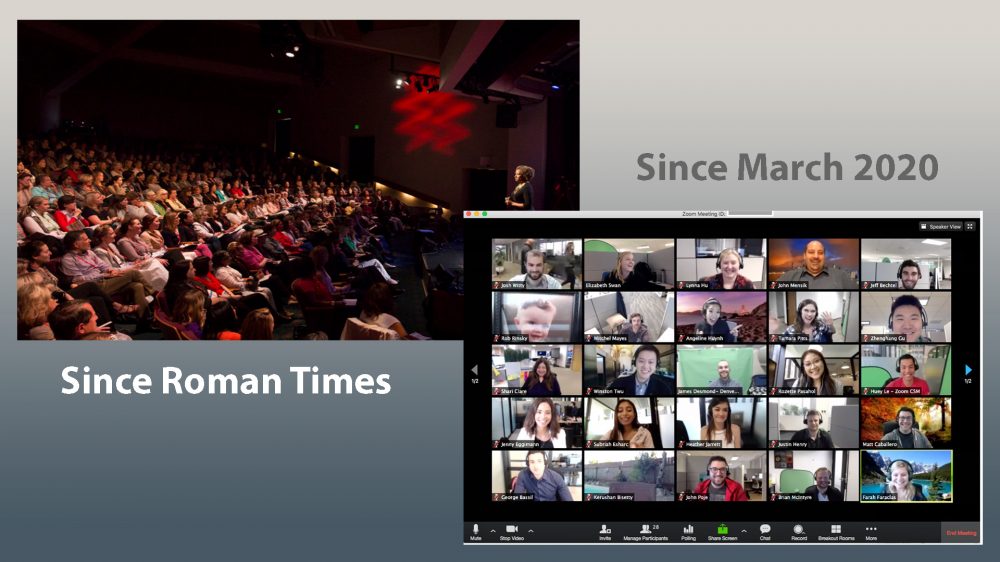
Executive Summary:
In 2022, meetings will often include attendees in multiple locations.
Typically, one group originates at the “live” venue with multiple independent participants joining remotely, over the Internet, using Zoom or other virtual meeting platforms.
The complexity of the Audio/Visual setup in the live venue increases depending on the expectation that all participants have equivalent experiences.
The Zoom meeting is an intimate one-on-one media.
The remote audience will expect that intimacy regardless of the host audience size and complexity.
In this tech world, though we would all like it to be different, nothing is as easy as turning on a light switch.
Backup and tech check an hour before each day’s event. Have access to tech help when you need it.
Did I need to emphasize more about WiFi BAD? If anyone in the house is watching Netflix or Disney, the home WiFi will not be good enough for video calls. In that case, insist that remote person just joins by telephone.
Here is an outline of AV support required for each of these options.
Meeting with no remote participants
For this, AV support expands with the size of the “live” audience. Ten people around a conference table don’t need microphones to hear each other. They can easily share a video screen with graphics or videos.
More than ten may require not only multiple microphones but also loudspeakers. The size of the video screen must also allow text to be seen clearly by the participant farthest away. Any lectern should not block the view of the screen for any participant.
Depending on the complexity of the presentations, technical support may still be needed to operate the equipment.
Adding a remote audience
If all the participants only hear each other without video, the conventional telephone conference is all that is needed. All participants in all locations should be able to speak and be heard by everyone else.
Generally, a Zoom “meeting” is an interactive, closed-loop of defined participants, each with their own camera and microphone.
If a remote audience is expected to participate in discussions or make presentations with the live audience, considerable attention is required for the technical support.
Zoom “webinar” – only a few designated panel members one-way to a remote audience.
Each requires a separate Zoom license.
Regardless of “Meeting” or “Webinar” assume all participants must be equally able to hear and see anyone speaking in any of the locations, this is the “hybrid” configuration.
Enough microphones must be deployed in the live venue to transmit quality sound to the remote audience. In turn, the remote participants must provide a microphone for themselves, usually over a smartphone, tablet, laptop, or desktop with a built-in camera or camera as an accessory (“webcam”).
Strict guidelines for good remote sound and images will avoid dark faces and garbled sound.
Each remote presenter should meet with the organizer (or producer representative) in advance to ensure consistent internet signal, sound, and video.
Corrections must be made in time to improve any deficiency well in advance of the hybrid meeting. Presenters are urged to avoid WiFi in favor of an Ethernet wire connected to their router.
The hybrid Audio Visual system should include:
- Multiple cameras in the live venue. They can be remote pan/tilt or operated by a camera operator(s).
- A video director to switch cameras providing meaningful video of each participant and graphics at the appropriate time.
- Multiple microphones (depending on the size of the room, considering acoustics, ambient noise, etc.)
- An audio technician with a sufficient mixing console to control the microphones, the outgoing and incoming audio.
- A PA speaker system to amplify the remote participants to the live meeting room.
- A large screen in the live venue displays the remote audience.
- In Zoom, a “Gallery View” switched to “Speaker View” as individuals speak remotely.
- A large screen increases the awareness of the originating audience that others are participating remotely.
- Graphics should be prepared to be legible to a remote audience watching on cell phones or tablets.
- A technical coordinator to manage the remote speakers and “spotlight” them as they contribute.
Decisions for success
- For the live meeting room, select a proper venue that has good acoustics and limited ambient noise.
- Also, allow space for a panel, production support, and additional participants that are not on the panel.
- AV support from the meeting venue should be detailed and reviewed by an experienced technician.
- A hybrid meeting often exceeds the most venue’s capabilities and this can be determined by demanding specific “Best Practices”.
- Internet transmission (Zoom) for all participants should not be over WiFi as audio quality and video reliability become questionable. The host venue and each Zoom contributor must hardwire to a router with a solid internet connection. If not, they should participate via phone only.
- For hybrid events, hire a producer or consultant to coordinate the technical complications well before the event being specific about the equipment, personnel, and configuration needed for success.
Consult requests – ray@presentationcoachray.com 702-879-8177
#PresentationCoachRay



